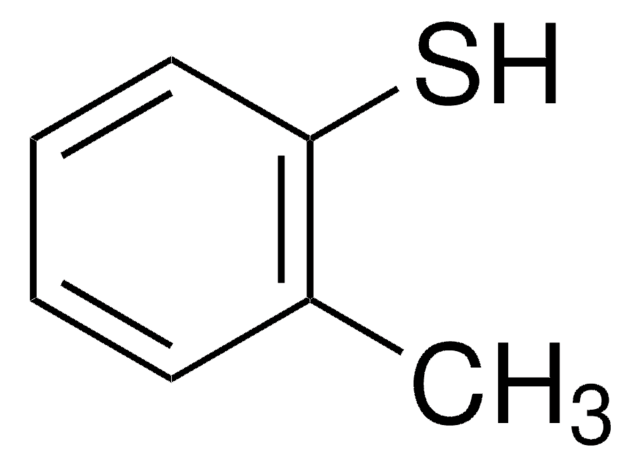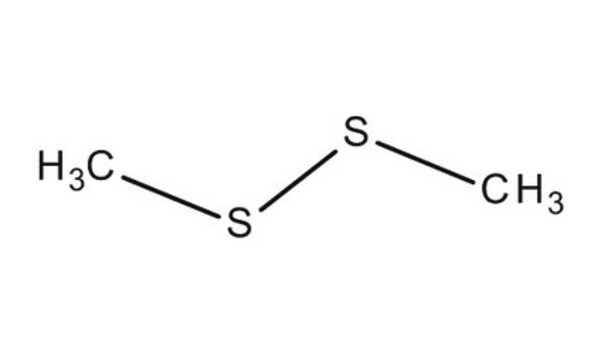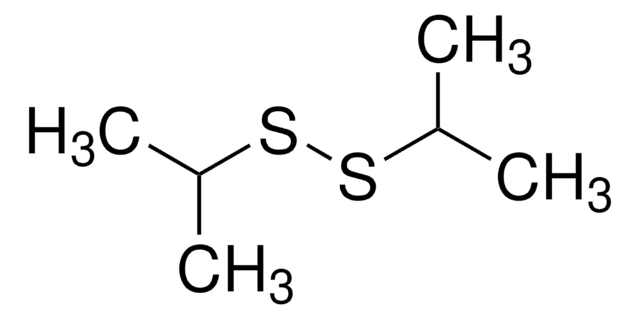W353604
Dimethyl disulfide
≥98%, FG
Sinonimo/i:
DMDS, Methyl disulfide
About This Item
Prodotti consigliati
Origine biologica
synthetic
Livello qualitativo
Grado
FG
Fragrance grade
Halal
Kosher
agenzia
follows IFRA guidelines
meets purity specifications of JECFA
Conformità normativa
EU Regulation 1223/2009
EU Regulation 1334/2008 & 178/2002
FDA 21 CFR 172.515
Densità del vapore
3.24 (vs air)
Tensione di vapore
22 mmHg ( 20 °C)
Saggio
≥98%
Temp. autoaccensione
>572 °F
Limite di esplosione
16 %
Indice di rifrazione
n20/D 1.525 (lit.)
P. eboll.
109 °C (lit.)
Punto di fusione
−85 °C (lit.)
Densità
1.046 g/mL at 25 °C (lit.)
applicazioni
flavors and fragrances
Documentazione
see Safety & Documentation for available documents
Allergene alimentare
no known allergens
Allergene in fragranze
no known allergens
Organolettico
cabbage; onion; vegetable; sulfurous
Stringa SMILE
CSSC
InChI
1S/C2H6S2/c1-3-4-2/h1-2H3
WQOXQRCZOLPYPM-UHFFFAOYSA-N
Cerchi prodotti simili? Visita Guida al confronto tra prodotti
Categorie correlate
Applicazioni
- GC-IMS-Based Volatile Characteristic Analysis of Hypsizygus marmoreus Dried by Different Methods.: Dimethyl disulfide is used to enhance the aroma of some fresh seafood to, this shows that it can be used to optimize flavor (Lai et al., 2024).
Avvertenze
Danger
Indicazioni di pericolo
Consigli di prudenza
Classi di pericolo
Acute Tox. 3 Inhalation - Acute Tox. 3 Oral - Aquatic Acute 1 - Aquatic Chronic 1 - Eye Irrit. 2 - Flam. Liq. 2 - Skin Sens. 1 - STOT SE 1 Inhalation - STOT SE 3
Organi bersaglio
Central nervous system, Upper respiratory tract
Codice della classe di stoccaggio
3 - Flammable liquids
Classe di pericolosità dell'acqua (WGK)
WGK 3
Punto d’infiammabilità (°F)
59.0 °F - closed cup
Punto d’infiammabilità (°C)
15 °C - closed cup
Dispositivi di protezione individuale
Eyeshields, Faceshields, Gloves, type ABEK (EN14387) respirator filter
Certificati d'analisi (COA)
Cerca il Certificati d'analisi (COA) digitando il numero di lotto/batch corrispondente. I numeri di lotto o di batch sono stampati sull'etichetta dei prodotti dopo la parola ‘Lotto’ o ‘Batch’.
Possiedi già questo prodotto?
I documenti relativi ai prodotti acquistati recentemente sono disponibili nell’Archivio dei documenti.
I clienti hanno visto anche
Il team dei nostri ricercatori vanta grande esperienza in tutte le aree della ricerca quali Life Science, scienza dei materiali, sintesi chimica, cromatografia, discipline analitiche, ecc..
Contatta l'Assistenza Tecnica.













